An imaginary interview and an animal portrait
Out and about in St. Johann Monastery with Babette
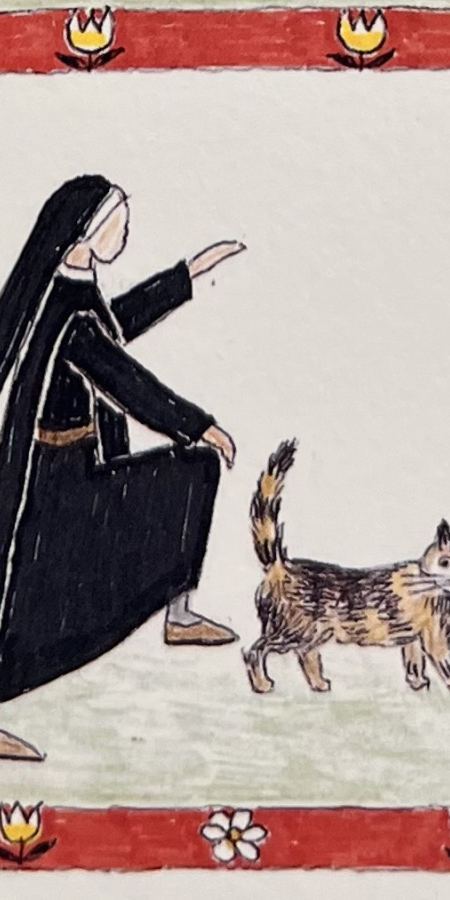
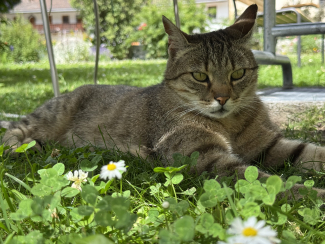
Val Müstair is not only known for its unspoilt natural and cultural landscape, but also for its above-average number of sunny days – around 1,800 hours of sunshine per year.
A true paradise, then, for cats who love to doze carefree in the sun for hours on end – or is it?
Yes, it's a real sun paradise and I love lounging on the warm stone benches or in the herb garden. But lazing around all day? That's not so easy here. There's always something to see, smell or observe – there's always something going on here. We only have one day off the whole year, which is 25 December, Christmas Day.
The rest of the year, we have around 40,000 visitors.
Since 2003, we have had a beautiful museum, which is a large former cloistered area that the sisters relinquished with a great deal of heartache. The museum is mainly housed in the Planta Tower – named after the famous abbess Angelina Planta, the monastery's greatest builder. This special place houses a cellar, a refectory, a dormitory and, at the top, baroque single cells, which have recently been refurbished and, with their new video stations, allow the sisters to tell visitors what motivated them to enter the convent and how they live their daily lives there. In addition to the Planta Tower, there is also an abbess's suite to admire, and although the suite is called the Hohenbalkenzimmer (high beam room), I advise you to duck your head when entering. Incidentally, there is also a bishop's outhouse there – a relic from the 10th century, when the tower was originally built for the Bishop of Chur.
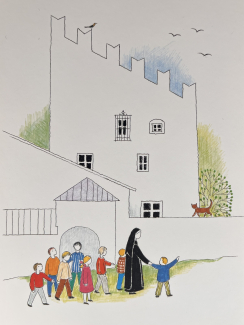
You can also visit a smokehouse, which was still used by the sisters until 1989, a 19th-century infirmary and the sisters' winter choir from the same period. Above the winter choir, there is also a solarium, known as the Juhée, to marvel at. What is it? The best way to find out is to take one of the public museum tours that take place twice a day from June to the end of October, where you will get a wonderful cultural and historical overview of the 1200-year history of the monastery. Magnificent Romanesque frescoes still adorn the north annex, the end of the tour.
Every now and then, I manage to sneak into the museum, because, as Benedict said, joy should fill the rooms of every convent. In search of this joy, I occasionally make my way to the Plantaturm. But it doesn't take long before the sisters come looking for me. Then it can happen that a restless sister runs through the museum calling my name loudly, searching for me and encountering groups of astonished visitors. The sisters are not deterred from climbing the last steep steps to the individual cells, so dear am I to their hearts.
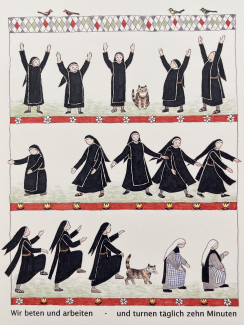
So you were really lucky to end up here! Can you tell us something about the history of the monastery?
My monastery was originally a monastery for men. According to dendrochronological data, the monastery dates back to 775. Legend has it that Charlemagne was its founder. Charlemagne, who was already King of the Franks, was crowned King of the Lombards in 774. On his way back after the coronation, he crossed the Umbrail Pass, where he was caught in a snowstorm. Grateful to have escaped the snowstorm unharmed, he had a monastery built here in the valley. This monastery was inhabited by Benedictine monks until the 12th century. In the 12th century, the monastery for men became a convent for women and has remained so without interruption to this day. Perhaps that is beneficial for me, because would I have been allowed to move in as a tomcat? That was a joke; the kind sisters would certainly have accepted me as a tomcat.
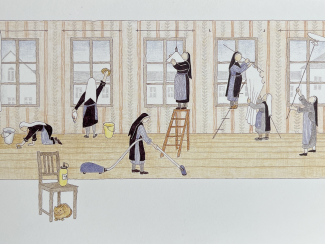
THE BENEDICTINE MONASTERY OF ST. JOHANN – A GIFT FROM THE PAST TO THE PRESENT
So you are essentially following in the footsteps of an emperor. As you wander through the corridors here, what is the beauty of being a cat in a monastery?
I am a privileged cat and live in a monastery that tells a story spanning more than 1,200 years. Over the course of those 1,200 years, the monastery has been rebuilt and extended many times, but never completely destroyed.
From the time the monastery was founded in the 8th century, the monastery church (albeit in Gothic form) and the Holy Cross Chapel still remain today. However, I am not allowed to explore these two centrepieces of the complex; it is strictly forbidden. But there are beautiful spots nearby where I love to listen to the sisters singing in the gallery twice a day, especially in summer. The church is also one of Switzerland's places of power, where sensitive people can feel a certain energy. Of course, this cannot be scientifically proven, but even I, as a sensitive cat, can often recharge my batteries a little near the church when I am tired from my explorations. I rarely stray into the cemetery, because I leave the departed in peace – but I particularly enjoy romping around in the farmyard and the garden, where there are so many flowers and herbs that my senses are often overwhelmed.
People say that I can recognise the cars of regular guests in the courtyard by the sound they make when they arrive for their break – because the monastery also has a guest house with cosy double and single rooms, which is run with great enthusiasm and professionalism by the monastery itself.
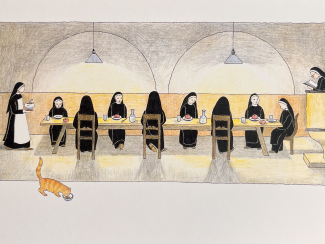
Sister Domenica grew up next to the monastery as a child, and she later described its beauty as follows: «Oh, how often I admired the monastery from the window of my parents' house. I loved to sit on the wide window sill and let my gaze wander to its sturdy towers. Majestic and sublime, it shone in all its glory and radiated a wonderful tranquillity. Sometimes it was as if its rays of light illuminated the entire valley. St. Johann Monastery was our rock and our joy.»
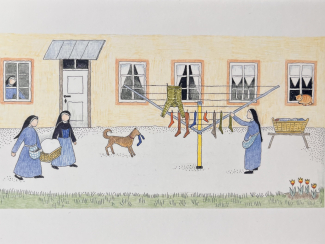
What else is there to reveal – or in this case, what else is there to discuss from the cat basket?
Last year, they set up a new exhibition in the museum. Each sister was allowed to choose a favourite object, and there is a story behind each one. And did you know that Sister Benedikta, whom I am very close to, is a big fan of the EHC Kloten ice hockey team? That her favourite object is a puck and a limited edition Kloten Flyers scarf? Secretly, she is known as the main prayer machine of the Kloten...
The sisters have exhibited even more exciting favourite objects, but I don't want to give everything away. It's better to come and visit the exhibition yourself.
And speaking of exhibitions: you can also admire drawings by Pia Willi at our premises – including the original drawings that illustrate my report here, as well as true works of art from before she entered the convent. Before entering the convent, Sister Pia attended art schools in Zurich and Paris, and her paintings are very popular.
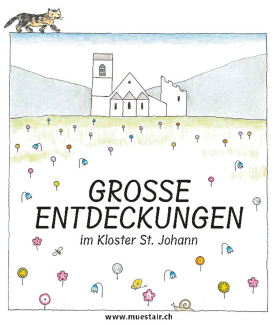
There is more life behind the monastery walls than you would think at first glance! But tell me, Babette – what makes St. Johann Monastery so unique?
The St. Johann monastery is a unique cultural and historical gem in our valley. It is a dreamy Alpine monastery that attracts many visitors, even if they are just passing through. Those who stay longer can explore our fantastic mountain world. There is still plenty of space on our hiking and cycling trails; you never feel crowded in Val Müstair. In Val Müstair, you can still breathe freedom.
And then there is Lai da Rims – a crystal-clear mountain lake, beautiful to look at, and it belongs to the monastery. In the past, the sisters visited it once a year, but today they live on their memories of it. Unfortunately, I was never there.
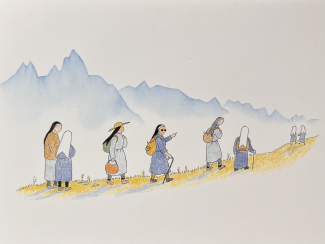
A MONASTIC JEWEL, CREATED OVER 1200 YEARS. IT OFTEN FEELS AS IF A WHISPER IS PASSING THROUGH THE OLD WALLS. WHAT COULD THEY TELL US?
Du hast wirklich ein besonderes Zuhause, Babette. Was macht dein Leben im Kloster für dich so einzigartig?
Für mich bedeutet das Kloster Heimat und Frieden, oder um es mit den Worten von Suor Domenica wiederzugeben: «Unser Haus ist ein kleiner Mikrokosmos mit vielen lieben Seelen, die wohlwollend und mit unermüdlichem Eifer die Geschichte des Klosters weiterschreiben. Kein Tag ist hier wie der andere, nichts ist morgen, wie es gestern war. Alles ist immer im Wandel und doch hat man manchmal von aussen betrachtet das Gefühl, es hätte sich nichts getan.»
Oder, wie es unsere Priorin so treffend zu sagen pflegt: «Wer andere glücklich macht, ist selbst glücklicher und strahlt in einem inneren Licht.»
Ich bin kein Nero Corleone, grosse Abenteuer sind nicht meins. Als Klosterkatze geniesse ich den Frieden, den das Kloster ausstrahlt und sonne mich in der daraus resultierenden Ruhe. Ich liebe es aber auch, die Gäste zu beobachten, die bei uns einkehren, und wünsche ihnen insgeheim:
Freude, dem der kommt.
Segen dem, der hier verweilt.
Friede dem, der weiterzieht.
Vielleicht kommen Sie mich und das Kloster auch einmal besuchen? Ich würde mich freuen.